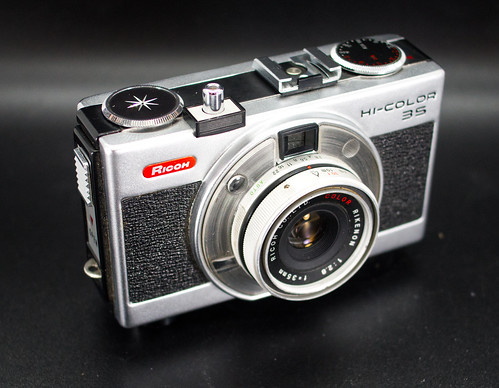Difference between revisions of "Ricoh Hi-Color 35"
Hanskerensky (talk | contribs) m |
m (Minor layout adjustment) |
||
| (16 intermediate revisions by 7 users not shown) | |||
| Line 1: | Line 1: | ||
{{Flickr image | {{Flickr image | ||
| − | | image_source= | + | | image_source= https://www.flickr.com/photos/21211062@N06/51238915629/in/pool-camerawiki/ |
| − | | image= | + | | image= https://live.staticflickr.com/65535/51238915629_cc47f1dafb.jpg |
| − | | image_align= | + | | image_align= right |
| − | | image_text= | + | | image_text= Ricoh Hi-Color 35 (second version with hot shoe) |
| − | }}{{ | + | | image_by= Corgi-boobs |
| + | |image_rights= with permission | ||
| + | }} | ||
| + | |||
| + | The '''Ricoh Hi-Color''' is a viewfinder camera for [[35mm film]] first sold in 1968, updating the spring-driven film advance concept [[Ricoh]] had promoted with the [[Ricoh Auto Half | Auto Half]] of 1962 and the [[Ricoh Auto Shot | Auto Shot]] of 1964. THe Hi-Color went through several generations, with the key differences: | ||
| + | |||
| + | * the Hi-Color (no "35") was the only model with a front-of-body shutter release, | ||
| + | * the Hi-Color 35 has a top plate shutter release (There were two versions. Later models had a hot shoe while the early ones had no accessory shoe.), | ||
| + | * the Hi-Color 35 S has a self-timer, | ||
| + | * the Hi-Color 35 BT was all black and had a more trapezoidal body shape. | ||
| + | |||
| + | What all models had in common were: | ||
| + | * a CdS meter, | ||
| + | * shutter priority automatic exposure plus manual exposure control, | ||
| + | * and spring powered motor drive. | ||
| + | |||
| + | The viewfinder comprises two objective lenses, an eyepiece, and two prisms in a double Porro formation <ref>A geometric prism with right-angled triangular end faces, such that light enters the rectangular face of the prism, is reflected twice from the sloped faces, and exits again through the large rectangular face. Because the image is reflected twice, it is not left/right reversed.</ref>, as found in binoculars. | ||
| + | |||
| + | One winding of the motor drive spring is sufficient for 15 exposures, which can be taken in rapid succession at the rate of one frame per second. | ||
| + | |||
| + | The USA Retail price in 1970 was $74 USD.<ref>[http://books.google.com/books?id=8dcDAAAAMBAJ&lpg=PA144&dq=%22lenco%20photo%20products%22&pg=PA144#v=onepage&q=%22lenco%20photo%20products%22&f=false Popular Mechanics, May 1970, p 144, Low-Cost Rapid-Fire Camera] (second version Hi-Color 35)</ref> The 1979 [[Ricoh AD-1 | Ricoh AD-1 and A-2]] continued the spring-drive concept in a slightly trimmed-down body. | ||
| + | |||
| + | {{Flickr_image | ||
| + | |image_source= http://www.ricoh-imaging.co.jp/japan/products/ricoh-filmcamera/index.html | ||
| + | |image= https://live.staticflickr.com/4605/24739998237_970e205d1c.jpg | ||
| + | |image_align= right | ||
| + | |image_text= 1968 first version, reflected | ||
| + | |image_by= OZBOX | ||
| + | |image_rights= wp | ||
| + | }} | ||
| + | ==Notes== | ||
| + | <references /> | ||
| + | |||
| + | ==Links== | ||
| + | * [https://www.cameramanuals.org/ricoh_pdf/ricoh_hi-color_35.pdf Ricoh Hi-Color 35 manual (PDF)] from Mike Butkus's [https://www.butkus.org/chinon/index.html OrphanCameras.com] | ||
| + | *[http://www.ricoh-imaging.co.jp/japan/products/ricoh-filmcamera/cameralist/hi-color.html Ricoh Hi-Color described (Japanese)] (and in [https://translate.google.com/translate?hl=&sl=ja&tl=en&u=http%3A%2F%2Fwww.ricoh-imaging.co.jp%2Fjapan%2Fproducts%2Fricoh-filmcamera%2Fcameralist%2Fhi-color.html&sandbox=1 Google Translate English] from Ricoh's company [http://www.ricoh-imaging.co.jp/japan/products/ricoh-filmcamera/index.html film-cameras history pages] | ||
| + | *[https://www.collection-appareils.fr/x/html/camera-6706-Ricoh_Hi-Color%2035%20BT.html Hi-Color 35BT] at [https://www.collection-appareils.fr/carrousel/html/index_eng.php collection-appareils.fr] | ||
| − | |||
| − | |||
[[Category:Japanese 35mm viewfinder]] | [[Category:Japanese 35mm viewfinder]] | ||
| − | [[Category:Ricoh]] | + | [[Category:Ricoh|Hi-color 35]] |
| + | [[Category:H|Hi-color 35 Ricoh]] | ||
| + | [[Category:Spring motor]] | ||
Latest revision as of 05:42, 23 November 2021

|
| Ricoh Hi-Color 35 (second version with hot shoe) image by Corgi-boobs (Image rights) |
The Ricoh Hi-Color is a viewfinder camera for 35mm film first sold in 1968, updating the spring-driven film advance concept Ricoh had promoted with the Auto Half of 1962 and the Auto Shot of 1964. THe Hi-Color went through several generations, with the key differences:
- the Hi-Color (no "35") was the only model with a front-of-body shutter release,
- the Hi-Color 35 has a top plate shutter release (There were two versions. Later models had a hot shoe while the early ones had no accessory shoe.),
- the Hi-Color 35 S has a self-timer,
- the Hi-Color 35 BT was all black and had a more trapezoidal body shape.
What all models had in common were:
- a CdS meter,
- shutter priority automatic exposure plus manual exposure control,
- and spring powered motor drive.
The viewfinder comprises two objective lenses, an eyepiece, and two prisms in a double Porro formation [1], as found in binoculars.
One winding of the motor drive spring is sufficient for 15 exposures, which can be taken in rapid succession at the rate of one frame per second.
The USA Retail price in 1970 was $74 USD.[2] The 1979 Ricoh AD-1 and A-2 continued the spring-drive concept in a slightly trimmed-down body.

|
| 1968 first version, reflected image by OZBOX (Image rights) |
Notes
- ↑ A geometric prism with right-angled triangular end faces, such that light enters the rectangular face of the prism, is reflected twice from the sloped faces, and exits again through the large rectangular face. Because the image is reflected twice, it is not left/right reversed.
- ↑ Popular Mechanics, May 1970, p 144, Low-Cost Rapid-Fire Camera (second version Hi-Color 35)
Links
- Ricoh Hi-Color 35 manual (PDF) from Mike Butkus's OrphanCameras.com
- Ricoh Hi-Color described (Japanese) (and in Google Translate English from Ricoh's company film-cameras history pages
- Hi-Color 35BT at collection-appareils.fr